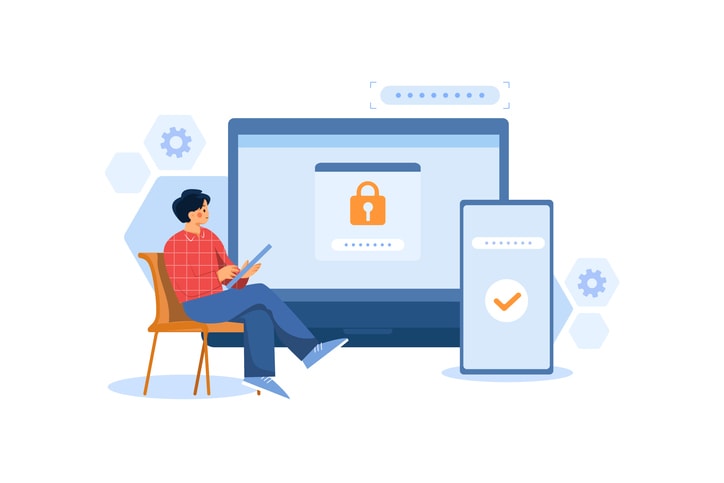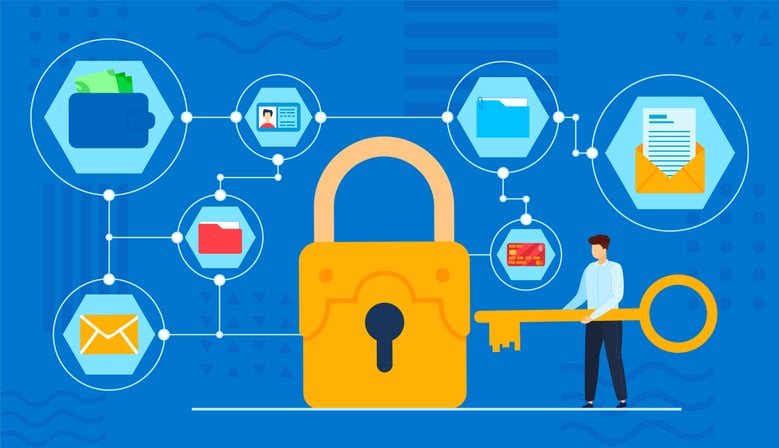In today’s fast-paced business world, secure video conferencing is more important than ever. With remote work and virtual collaboration on the rise, ensuring the safety and privacy of your communications is paramount. So, how do you choose the best secure video conferencing solution for your organization? We’ve done the legwork for you and compiled a list of the top 7 secure video conferencing solutions for 2024 that offer robust security features and reliable performance.
Short summary
- Secure video conferencing requires strong authentication methods, encryption, and compliance with data protection regulations.
- The top 7 secure video conferencing solutions for 2024 are Kumospace, Microsoft Teams, Google Meet, Zoho Meeting, Pexip , ClickMeeting and Livestorm.
- Best practices such as employee training and security policies should be implemented to ensure the security of virtual meetings.
Understanding video conferencing security

Video conferencing security is essential to protect confidential information and prevent unauthorized access when using secure video conferencing software. Risks associated with using an insecure platform include exposing sensitive information, violating confidentiality laws, and potentially fatal consequences for businesses in certain industries during a secure video conference. Therefore, it’s crucial to choose a secure video conferencing platform that offers robust security features and adheres to data protection regulations like the General Data Protection Regulation (GDPR) and the Health Insurance Portability and Accountability Act (HIPAA). Thankfully, platforms like Kumospace offer both GDPR and HIPAA compliance for safe and secure video conferencing.
To ensure the utmost security of live video calls using a secure video conferencing app, several steps and practices should be followed. These include using encrypted communication, strong authentication methods, and compliance with data protection regulations. In addition, it’s essential to be cautious when utilizing public Wi-Fi networks for video conferencing, as they can potentially expose sensitive information to risk. It’s especially important to consider your Wi-Fi choice when working remotely while traveling in unfamiliar areas. Employing a VPN, like NordVPN, can help secure data and provide a stable connection for a seamless video conferencing experience.
Key features of secure video conferencing platforms

When searching for a secure video conferencing solution, it’s important to consider the platform’s key secure video conference features, which should include encryption, authentication, and compliance with data protection regulations. These essential features ensure that your video calls are protected from unauthorized access and that sensitive data remains confidential during virtual meetings.
In the following subsections, we’ll delve into the specifics of these crucial security features.
End-to-end encryption
End-to-end encryption plays a vital role in secure video conferencing by providing a secure communication channel and safeguarding sensitive data during video conferences. This level of encryption ensures that only the intended recipients can access and decipher the information being shared, significantly reducing the risk of data breaches and unauthorized access.
Transport Layer Security (TLS) encryption is often recommended for voice and video data in video conferencing software, while AES-256 and TLS/SSL mechanisms are utilized by platforms like MirrorFly for encryption during video calls. Robust encryption not only protects your communications, but also helps to maintain the privacy and integrity of your organization’s information.
Strong authentication methods
Strong authentication methods, such as two-factor authentication, play a crucial role in preventing unauthorized access to video conferences. By requiring users to provide two forms of identification before accessing a meeting, it becomes more challenging for unauthorized users to gain entry, even if they possess the user’s sign-in credentials.
Domain-based security is another effective authentication method that offers additional protection for video conferences. It provides moderators with the ability to manage the participants who join meetings or webinars, ensuring that only approved participants can access the video conference and preventing unauthorized access.
Compliance with Data Protection Regulations
Compliance with data protection regulations, such as GDPR and HIPAA, is crucial for secure video conferencing, especially in industries handling sensitive information. Adhering to these regulations not only demonstrates your organization’s commitment to data privacy and security, but also helps to avoid any potential legal ramifications or financial penalties.
When evaluating a secure video conferencing platform, it’s essential to inquire about the provider’s compliance with data protection regulations and any relevant certifications they may hold. Platforms like Kumospace and Slack are compliant with GDPR and HIPAA.
Top 7 secure video conferencing solutions for 2024

Now that we’ve covered the essential security features of secure video conferencing platforms, let’s dive into our top 7 picks for 2024. These solutions offer robust security features, reliable performance, and user-friendly interfaces, ensuring that your virtual meetings are both efficient and secure.
The top 7 secure video conferencing solutions for 2024, including the best secure video conferencing tool options, are Kumospace, Microsoft Teams, Google Meet, Zoho Meeting, Pexip, ClickMeeting, and Livestorm. In the following subsections, we’ll discuss each of these platforms in detail, highlighting their unique features and security capabilities.
Kumospace

Kumospace is an advanced video conferencing platform that offers cutting-edge spatial audio capabilities and robust security measures. The platform’s unique spatial audio feature sets it apart from other solutions, providing a more immersive and engaging virtual meeting experience.
Security features provided by Kumospace include Single Sign-On (SSO), end-to-end encryption, and cloud storage. These measures help to protect your virtual meetings from unauthorized access and ensure the privacy and integrity of your organization’s data.
With its innovative features and strong security capabilities, Kumospace is a top choice for secure video conferencing in 2024.
Microsoft Teams
Microsoft Teams is a comprehensive and secure video conferencing solution for businesses, offering robust encryption and compliance features. The platform is known for its user-friendly interface and collaboration capabilities, including 1:1 online meetings, team collaboration, and live events.
In terms of security, Microsoft Teams provides strong encryption, compliance with data protection regulations like GDPR and HIPAA, and a transparent security program to ensure the safety of your virtual meetings.
Google Meet
Google Meet offers a secure and user-friendly video conferencing experience, suitable for both personal and corporate use. The platform seamlessly integrates with Google’s software suite, such as Google Calendar and Gmail, making it easy for users to schedule and join meetings.
In terms of security, Google Meet provides Multi-Factor Authentication (MFA) and Single Sign-On (SSO) authentication, a transparent security program, malware prevention, and data protection.
With a free account, users can host meetings of up to 60 minutes with a maximum of 100 participants, while paid accounts provide unlimited meetings and support for up to 250 participants.
Zoho Meeting
Zoho Meeting is a secure video conferencing platform that emphasizes encryption, privacy, and host-controlled features. This focus on security helps to protect virtual meetings from unauthorized access and safeguards sensitive data during video conferences.
The platform offers interactive features, including audience polls, Q&A sessions, and the Raise Hand option, allowing for more engagement and collaboration during virtual meetings.
Pexip
Pexip is an AI-powered video conferencing platform that offers encrypted communication and pin-protected virtual meeting rooms for enhanced security during video conferences. This level of protection ensures that only authorized participants can access your virtual meetings, helping to maintain the privacy and integrity of your organization’s information.
ClickMeeting
ClickMeeting is also an AI-powered video conferencing platform with a strong focus on security and reliable communication solutions. The platform offers a wide range of features that cater to businesses of all sizes.
Security features provided by ClickMeeting include encryption, compliance with data protection regulations, and a transparent security program.
Livestorm
Livestorm is a browser-based video conferencing tool known for its security features, ease of use, and screen sharing capabilities. The platform is compatible with all modern browsers, making it accessible to users on various devices without the need to download additional software.
Security features provided by Livestorm include MFA and SSO authentication, the latest encryption standards for audio and video, as well as IDS and IPS to prevent malware and protect data.
Best practices for secure video conferencing

To ensure the security of your video conferences, it’s essential to implement best practices such as employee training, software updates, and security policies. Regularly training your employees on cybersecurity protocols and practices helps them stay informed about potential security threats and how to prevent them. Keeping your video conferencing software up to date is also crucial, as it helps protect against potential malware, viruses, and other cybersecurity risks.
These policies help establish secure parameters during video conference calls, encouraging accountability and responsibility for safety. By following these best practices, you can ensure the security and privacy of your virtual meetings.
Evaluating and choosing a secure video conferencing solution

When evaluating and choosing a secure video conferencing solution, it’s important to consider factors such as transparency, certifications, and security features. Inquiring about the platform’s security program transparency, cyber insurance coverage, encryption capabilities, and adherence to essential security principles can help you make an informed decision.
Certifications such as GDPR, ISO 27001, and SOC 2 should also be taken into account when evaluating a secure video conferencing platform. Platforms that demonstrate compliance with data protection regulations and possess relevant certifications are more likely to provide robust security features and protect your organization’s data.
By considering these factors, you can confidently choose the right secure video conferencing solution for your needs.
Summary
In conclusion, secure video conferencing is of utmost importance in today’s digital landscape. By understanding the key security features, such as end-to-end encryption, strong authentication methods, and compliance with data protection regulations, you can better evaluate and choose the right secure video conferencing solution for your organization. Our top 7 picks for 2024 offer robust security features and reliable performance to help ensure the privacy and integrity of your virtual meetings. By following best practices and selecting a secure platform, you can confidently conduct virtual meetings while safeguarding your organization’s sensitive information.
Frequently asked questions
Services like Kumospace, Zoom and Google Meet provide users with the ability to securely communicate with colleagues, friends, and family. They offer features such as end-to-end encryption, two-factor authentication, and password protection to ensure that conversations remain private. In addition, there are several improvements.
To secure your video conferencing, always create a meeting ID and password, lock the meeting when not in use, avoid unnecessary sharing of links, set up a waiting room, and enable screen sharing only when required.
These steps will help ensure that your video conferencing is secure and private. Additionally, it is important to be aware of the security settings of the platform you are using and to be aware of any potential risks.
Teams and Wire provide more robust security than Zoom, with end-to-end encryption and additional security features for their Enterprise plans.
These solutions offer a safer alternative to Zoom for private conversations.
Secure video conferencing requires encryption, authentication, and adherence to data protection regulations to ensure maximum security.





